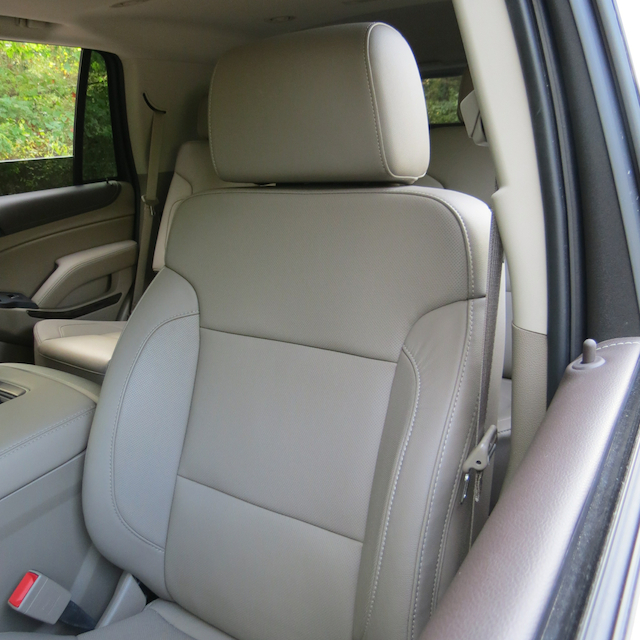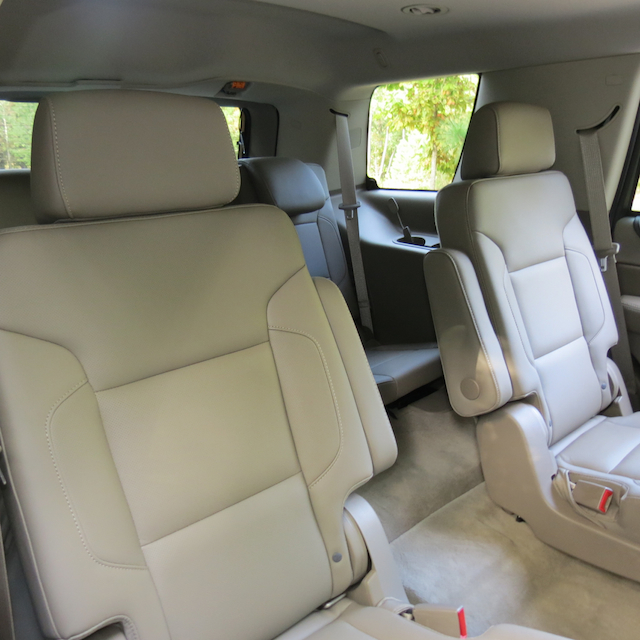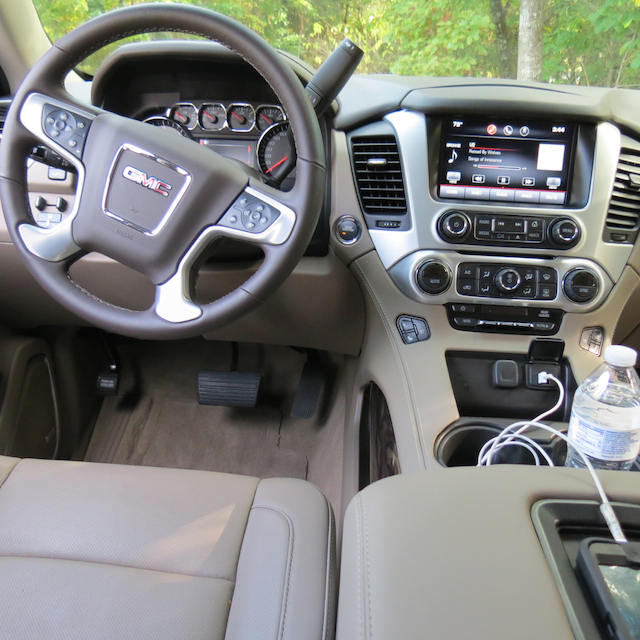Living large with GMC’s big SUV.
Oversized sport utility vehicles seem like a throwback to a different era for some. For those who own them or aspire to acquire one, these models deliver the best amalgamation of passenger room and trailering capabilities in the business.
Fuel costs can be exorbitant, but with the prevailing price of gasoline dropping below $2 per gallon in most states, the appeal for such vehicles has increased once again.
The GMC Yukon is a full-size, traditional rear-wheel drive SUV, available in four-wheel-drive, standard and stretched (XL) wheelbases as well as in Denali trim. Consequently, shoppers have much to scrutinize when considering the Yukon line, a model that competes with the Ford Expedition, Toyota Sequoia and Nissan Armada.
2015 GMC Yukon Review
GMC prices the base 2015 Yukon from $46,990, the Yukon XL from $49,690, the Yukon Denali from $63,770 and the Yukon XL Denali from $66,470. Choose four-wheel drive and you will add $3,000 to your base price. Notably, a fully-equipped stretched wheelbase Denali model can cost you more than $75,000.
For test purposes GMC delivered a Yukon XL 2WD SLT edition priced from $54,735 and equipped with the standard 5.3-liter V-8 engine making 355 horsepower and 383 foot-pounds of torque.
Alternatively, a 6.2-liter V-8 engine making 420 horsepower and 460 foot-pounds of torque is available and is also the standard engine found in the top-of-the-line Denali trim level. Both engines are paired with a six-speed automatic transmission, but Denali models get GM’s new eight-speed automatic.
Fully redesigned for 2015, the current Yukon/Yukon Denali offers a familiar silhouette with a refreshed grille, new headlamps and LED lights, redesigned inlaid doors for improved aerodynamics, a modern family of wheels, laminated windshield and front door glass to boost quietness, and a standard rear spoiler.
As always, the GMC Yukon is built on the same truck platform that underpins GM’s big pickup trucks, including the GMC Sierra.
Quiet Cabin, Updated Interior
Inside, seating is for seven to nine people. The ideal arrangement may be two bucket seats up front, a pair of captain’s chairs in the second row and a third row bench seat.
To offer room for nine, the second and third row seats are replaced with bench seats, but at a significant loss of storage space up front. The test model was a seven-seat SUV, what fully accentuates the cavernous interior.
The Yukon’s interior is dominated by an expansive dashboard, covered in soft touch materials and accented by French seam stitching. Excellent interior lighting, including ambient lighting, chases darkness away from every nook and crevice.
All seats are firm and supportive, although third-row thigh support isn’t as good as you would find elsewhere.
GMC offers a long list of standard equipment with the Yukon. All models are equipped with a Bose audio system. An 8-inch color touch screen dominates the center console and provides voice commands, SiriusXM and HD radio, USB ports, auxiliary jacks, an SD card slot, Bluetooth streaming and hands-free calling.
You also get tri-zone climate control, power accessories, cruise control, OnStar directions and connections, a 110-volt power outlet, a leather-wrapped tilt and telescope steering column and floor mats.
Move up to the SLT edition from the SLE and this model brings in improved interior lighting, heated and cooled front seats, heated outboard second row seats and a power folding 60-40 split bench seat.
As for the Denali edition, this model brings in active noise cancellation technology, a customizable driver display and leather nearly everywhere.
Available options include: an enhanced security package, an open road package with a power sunroof and navigation, a rear-seat Blu-Ray/DVD entertainment system, a head-up display and a number of dealer-installed accessories such as a reflective window shade.
The SLE edition provides premium cloth covered seats with leather seats found in SLE and Denali editions. Not surprisingly, the 10-way power driver’s seat places the emphasis on comfort, offering power recline, 2-way power lumbar control and even a 6-way power cushion.
That seat plus the adjustable steering column provides scores of positioning permutations to rebuff driver fatigue. Similarly, the front passenger is also spoiled with a thoroughly comfortable seat.
Think hard before you consider swapping out the front bucket seats for a bench seat. Unless you know that you must have room for nine, the added seating space also means that the cavernous storage compartment and console between the front seats will be eliminated.
Certainly, there are many other storage areas found in this model — the glove box, seat backs, the doors and behind the rear seat — but chances are you will find the bench arrangement wanting.
On the Road
With no boat, camper or trailer to pull, I cannot comment on the Yukon’s towing capabilities. What I can tell you is that this model is rated to pull from 7,900 pounds (Yukon XL Denali 4WD) to 8,500 pounds (Yukon 2WD) and has a payload capacity that starts around 1,500 pounds and tops out at 1,676 pounds.
To put it another way, you can bring with you a full contingent of people, load up the rear storage area and pull that big boat without much effort. I’m basing my perspective strictly on anecdotal evidence, observing the many SUVs in my area that carry a full load and seem none the worse for it.
Get behind the wheel of any Yukon and you’ll sense that you have full command of the road. In many ways you do as ground clearance, its large tires and the SUV’s overall height make for one imposing model.
What I think will interest most shoppers is the difference between the two V-8 engines. Both provide generous amounts of power, but you will enjoy a near 20 percent boost in power by choosing the larger engine.
I can see where that power would come in handy when pulling anything up a hill or even retrieving a large boat from the water.
The Yukon XL extends the standard wheelbase from 116 inches to 130 inches and overall length from 203.9 inches to 224 inches. That’s a different approach then, let’s say the Ford Expedition, where the extra space is consigned strictly behind the third row seat.
The XL’s extended proportions also means this model seems to float down the road. It handles well and makes U-turns without needing a third opposite flowing lane to make that maneuver. Involved driving? You won’t find it. Consume potholes with relative ease? The GMC Yukon does that.
For the best suspension you’ll need to upgrade to the Denali as it comes outfitted with magnetic ride control, a suspension system used in the Corvette Stingray, Cadillac CTS and other premium GM vehicles.
The Yukon’s braking system is composed of power-assisted, four-wheel disc, four-wheel anti-lock brakes using “Duralife” rotors and vented front and back. Standard and available safety features include: a front center airbag, radar-controlled cruise control, side blind zone alert, lane departure warning and automatic crash response.
Parting Thoughts
So how much does it cost to fill the tank of a GMC Yukon? Believe it or not, that’s a question that I often get from people that are considering a large SUV.
Outfitted with a 31-gallon fuel tank, fill ups would have cost you well over $100 when the price of the regular grade gasoline it takes came in at $4 per gallon. Likewise, you will pay about $65 per fill up for a vehicle (as of this date) that averages 20 mpg under optimum driving conditions.
It is doubtful that gasoline prices will stay down for the long term, so keep that cost in mind when shopping for any large SUV. Moreover, you should expect to pay about $60,000 for a well-equipped standard wheelbase model outfitted with four-wheel drive and many of the amenities mentioned herein.
|
2015 GMC Yukon XL photos copyright Auto Trends Magazine.
- 2024 Mazda CX-50: A Compact SUV with Premium Aspirations - Apr 15, 2024
- 2024 Ford Mustang (Iconic Pony Car Evolves) - Apr 4, 2024
- 2024 Ford Maverick (Looks Like a Truck, Drives Like a Car) - Mar 28, 2024








